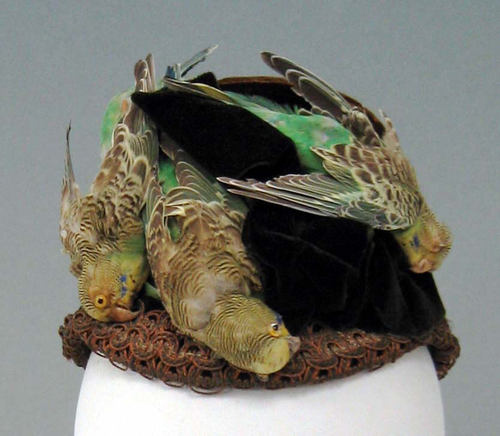Quickies
Quickies: Nerd dating, Lovecraft, and bird hats

- How to correct a date on nerd knowledge – It’s a choose your own adventure comic, even.
- GoDaddy CEO: Why women are turned off by the tech industry – From Amy, who aptly sums the article up as, “This may be the singularity of mansplaining.”
- Lovecraft apologists and the World Fantasy Award – Content warning: Racist slurs, as used by Lovecraft.
- How the bird hat craze almost killed the dinosaurs – “A single 1892 order of feathers by a London dealer… included 6,000 bird of paradise, 40,000 hummingbird and 360,000 various East Indian bird feathers.”





404 on the Lovecraft link. Was it supposed to go to Jim C Hines blog here?
http://www.jimchines.com/2014/10/lovecraft-apologists-and-the-world-fantasy-award/
Thanks! Fixed now.
I must be missing something. The “GoDaddy CEO: Why women are turned off by the tech industry” article looks like an article by someone who gets it, and is doing something about it. So it was strange to see it described as “the singularity of mansplaining.” What am I overlooking?
Ditto.
I recognize that he is identifying a lot of simple and obvious problems that people who visit this site are overly familiar and schooled in, so there is an element of, “Duh,” to the piece. But obviously, there are many people who simply don’t get it, especially in the CEO, business, and tech worlds. I thought the article indicated that he recognized a lot of the problems, understood some of the problems, and had at least one creative solution for the problem (ensuring that certain teams had >= 50% women). I found it refreshing, but perhaps I have extremely low expectations at this point.
Go Daddy’s commercials have been pretty sexist. They’d basically just have near-naked, overly sexualized women hawking their product. So although the article itself may have some decent information, it’s kind of ironic to be coming from Go Daddy. Seems that the article forgot to mention “Objectifying women in marketing material may dissuade women from joining your company.”
Actually, the article did mention this.
GoDaddy’s got a nasty history, and I still wouldn’t patronize them as a customer. But it does seem like the new CEO is trying to turn it around. I don’t think the article was perfect (e.g., from the quote above, it wasn’t just women that found the commercials objectifying — and I think they were insulting to people of all genders), but to me to seemed like a fairly sincere attempt to discuss sexism in the tech industry and what management steps can be taken to address it.
I’m with Richard Carrier; I didn’t see the mansplaining in the article. This could be a blind spot on my part, so I wonder if Amy or someone else who read the article as mansplaining can help us see their perspective?
Oh! My bad. I admit I just skimmed the article. Well good on the new CEO!
My first thought after seeing the first GoDaddy ad, the combination of sexploitation with the name, was Apparently incest has moved out of fanfiction. Is that weird?
And yeah, I’m sure there’s some way of associating Danica Patrick, a NASCAR driver, with speed. But how would we associate NASCAR with speed? Hmm…I got nuthin.
Forgot to mention? You mean this part doesn’t count as a mention of that problem: “My first act as CEO was to completely overhaul our brand and advertising—dropping the commercials that women clearly articulated to be objectifying and over-sexualized”?
I too am having trouble seeing where this counts as mansplaining and would value the insight.
Yea… I missed that part. The new CEO seems to be trying to fix their previous image.
How does one write a blog post about the bird hat craze leading to endangered bird species without even mention one of the most stunning cases of man-created extinction ever? Especially one that stemmed directly from that very craze?
The estimated passenger pigeon population of North America in the mid 19th century was around a billion or so (that is not a typo, that’s billion with a b) yet by 1914 the final known specimen had died in a Cincinnati zoo. The cause was chiefly the fashion of the day. One billion to no more in little more the fifty years is impressive, but not in any good way.
There is a great article on the extinction of the passenger pigeon in Audubon Magazine earlier this year (this being the 100th anniversary and all) that also touches on the push by some to recreate the passenger pigeon using genetics. Very interesting.
After reading through the article I linked to it looks like I have fallen for a misconception (yeah yeah, I know), I remember being told, and reading in magazines including National Geographic in the 70s and 80s that the passenger pigeon was done in by women’s hats. Turns out they were eaten to death for the most part, it was just pinned on fashion. (no pun intended)
I am stunned that men would hunt pidgies to all gone and blame women. How could that have ever happened in Ameri…
You know, never mind.
What really hit the passenger pigeons was habitat loss and market hunting. Specifically they needed large areas as rookeries, and the market hunters would burn the rookeries so that the chicks would jump from the trees where they could be easily collected for the eastern squab market. So the pigeons lost not only that years production, but the rookeries as well. They also needed large numbers for successful reproduction, so once they dropped below the tipping point they were done.
The snowy egret was almost wiped out by the feather trade, because of it’s white feathers.
If you are ever in town I recommend visiting the memorial to Martha, the last Passenger Pigeon as well as the last Carolina Parakeet. It has always chilled me, the only place in the Zoo with no live animals on display.
Maybe I’m a horrible person for mentioning this, but I once visited Martha’s memorial at the Cincinnati Zoo. There was a woman with a small boy (possibly her grandson.) She told him “Martha was the last passenger pigeon. They don’t have passenger pigeons any more. Now, all they have are freight pigeons.”
That woman is my hero.
Eliminate! Exterminate! Totally Destroy!
At least the Daleks were honest about it.
It’s interesting you mention the 100th anniversary because for that reason I was reading up on the history of WW1 (specifically my grandfather’s role in the capture of German New Guinea in October 1914).
The official histories note that under Australian administration the exploitation of Birds of Paradise for feathers was significantly ramped up. Not one of our finest hours in many ways, I suspect – although I have only scratched the surface so far.
So that phase of the feather craze seems to have lasted well beyond the Audubon Society ban – I wonder how long? Is it that the ban simply shifted the source from domestic to colonial sources? How much of the problem still persists today?
Well, that was interesting coming from the CEO of GoDaddy given the company’s past image. There were surely better ways to connect Danica Patrick to high-speed web service than her body.
However, another CEO speaking at the Grace Hopper conference did manage to open mouth insert foot. That would be Satya Nadella, the newly minted Microsoft CEO. His advise to women: “It’s not really about asking for a raise, but knowing and having faith that the system will give you the right raise.” Faith? In the system that systematically undervalues women? You have to wonder what planet he’s living on. Perhaps this is the mansplainin’ episode.
According to this article in Money, there was a panel discussion including Mike Schroepfer (Facebook CTO), Blake Irving (GoDaddy), and Alan Eustace (Google SVP), all of whom managed to say something as inept as Nadella (who since apologized in a email to MS staff). For example, the article quotes Irving as saying, “The only thing I would add is speak up … Speak up, be confident.” Sure, except…well, I probably don’t need to explain the consequences to women for speaking up and being confident. Not to mention the fact that women (and some men) have been speaking up about the disparity for decades.
Lovecraft apologists…That’s weird. Personally I’d be more surprised to find a typical white man in the 1930s wasn’t racist. This was the era when Hollywood looked for any excuse to do a blackface routine, after all.
I brought it up to a Lovecraft group, and their feeling was similar. While he was horribly racist, he was pretty typical for the time. They felt that as long as no one was trying to put his face on an award for racial harmony it wasn’t worth the fuss. Of course they might be a little biased.
There were some suggestions else where that they change to bust to Cthulhu.
re – Bird and Hats. extract “The huia was probably the greatest loss to New Zealand’s unique avifauna. It became extinct in 1907 after extensive hunting for collections and its tail feathers, which were in great demand due to an international fashion of wearing them in hats. The male and female were so sexually dimorphic with different straight and curved beak forms, they were at first thought to be separate species.”